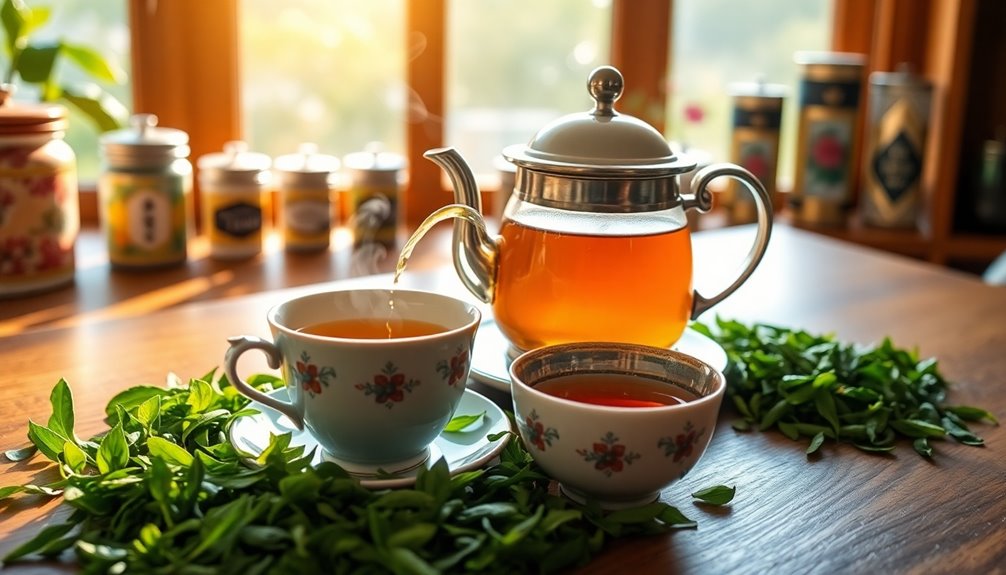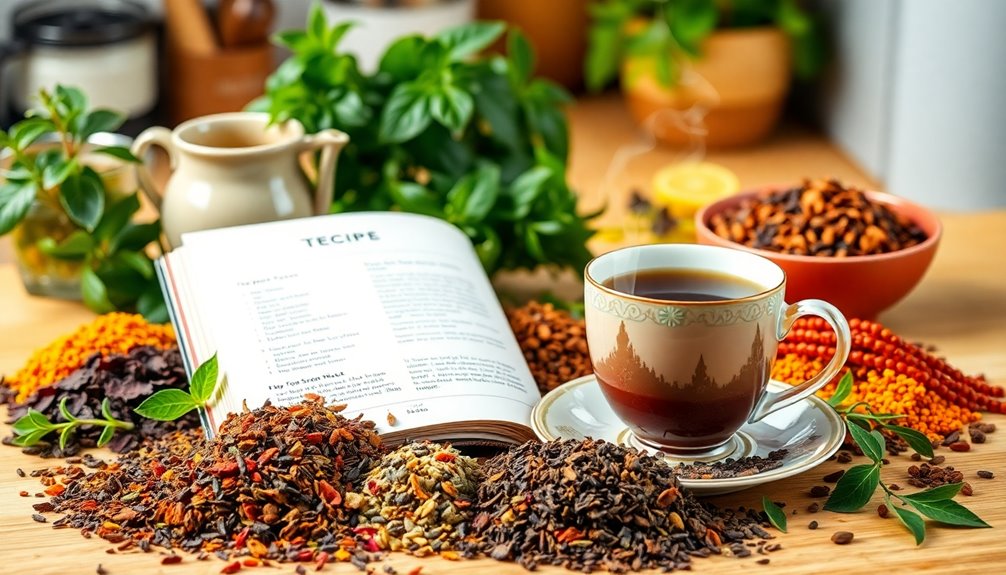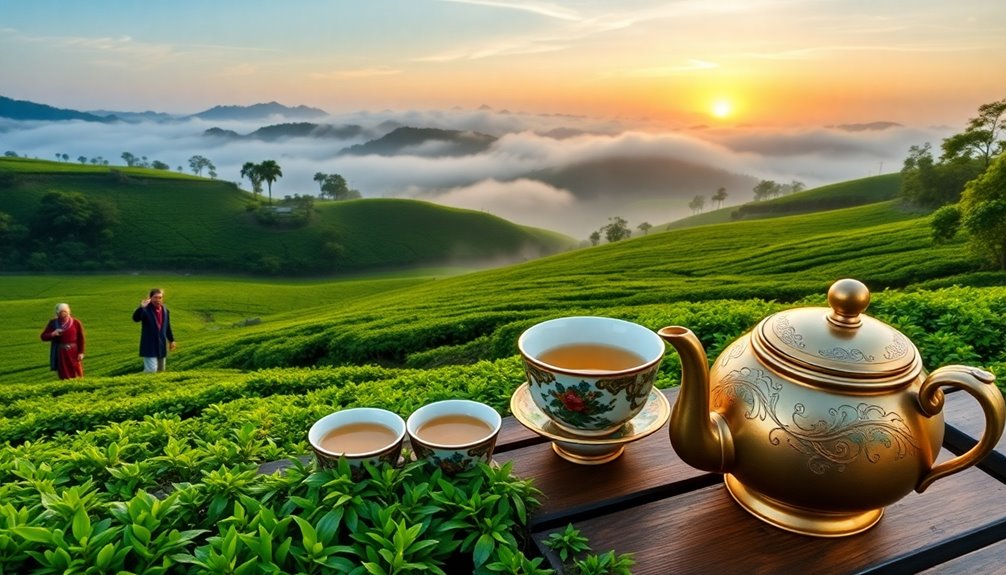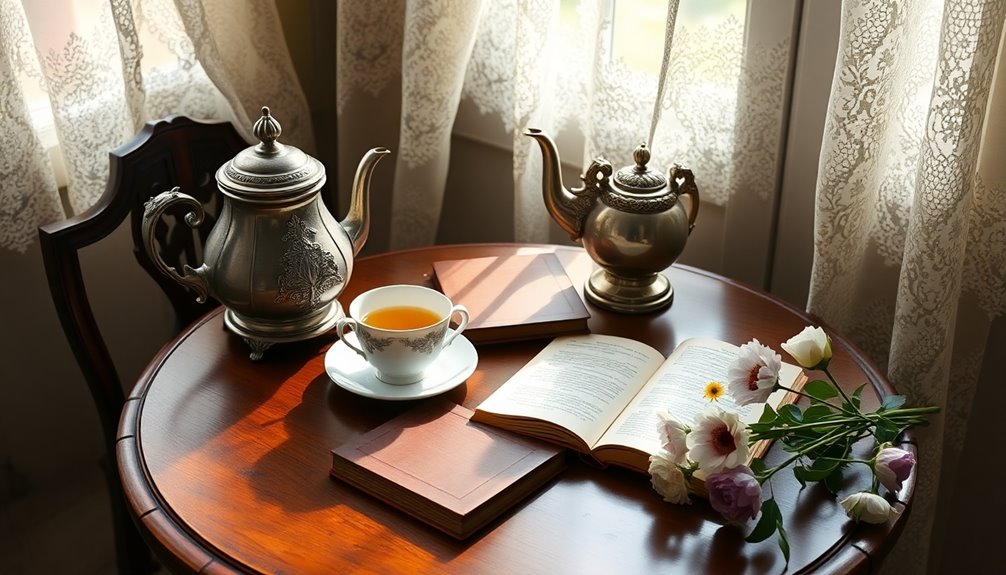This book transforms your tea knowledge by revealing its rich tapestry of history, culture, and health benefits. You'll discover the nuances of different tea types, from delicate white to robust black, and appreciate the artistry behind traditional tea ceremonies. Henrietta Lovell shares her travels through China's tea gardens, promoting high-quality loose leaf. You'll learn about the health advantages of herbal teas and the importance of mindful consumption. With insights into global traditions and cultural significance, it's more than just tea—it's a connection to the world. This journey opens doors to deeper appreciation and understanding ahead.
Key Takeaways
- The book delves into the diverse types of tea, enhancing my understanding of their distinct flavors and brewing techniques.
- It highlights the cultural significance of tea, allowing me to appreciate global traditions and ceremonies associated with its consumption.
- Insights from Henrietta Lovell emphasize the importance of high-quality loose leaf tea, transforming my approach to tea selection and enjoyment.
- Detailed information on health benefits and preparation of herbal teas expanded my knowledge of their therapeutic properties and proper brewing methods.
- The book addresses cultural appropriation, encouraging respect for tea's origins and promoting mindfulness in tea rituals and consumption.
Introduction
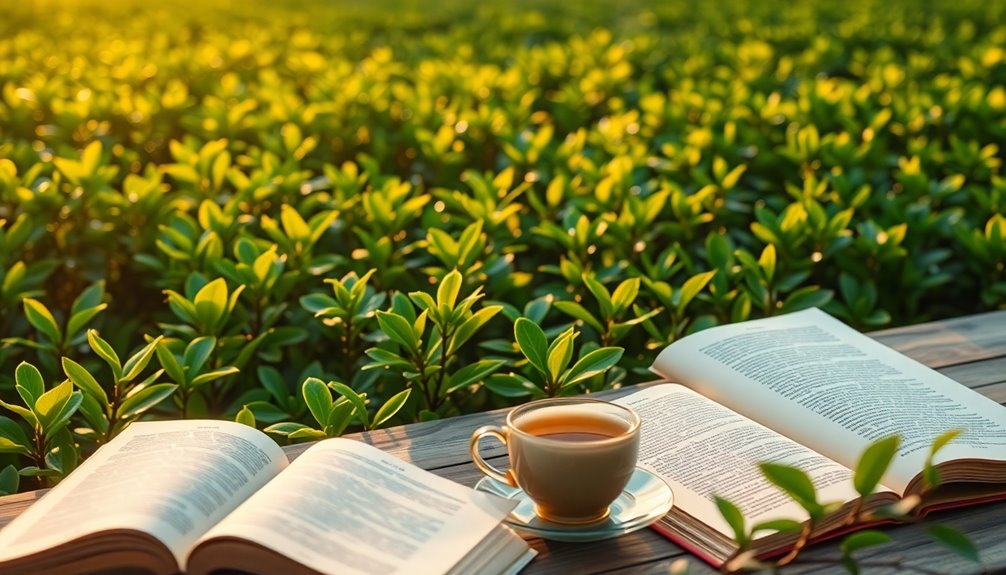
In a world where the simple act of enjoying a cup of tea can connect you to diverse cultures and histories, the journey into tea knowledge becomes an enriching experience.
This book about tea opens your eyes to the vast types of tea, from delicate white to robust black, each with unique characteristics and origins. You'll discover the intricacies of loose leaf tea and how it differs from bagged varieties, enhancing your appreciation for quality. Additionally, the book highlights the cultural significance of beverages like yerba mate, which is celebrated in social gatherings across South America.
The author's engaging anecdotes and travel stories bring tea culture to life, illustrating its significance across different societies. You'll learn essential brewing techniques, like the right water temperatures and steeping times, ensuring you extract the best flavors from each brew.
This knowledge not only transforms your tea experience but also deepens your understanding of tea pairing, making every meal an opportunity for culinary exploration. Furthermore, understanding the health benefits of tea can motivate you to incorporate it into your daily routine for overall well-being.
As you engage with this narrative, you'll find yourself reflecting on your own relationship with tea. The ritual of preparing and savoring tea can lead to personal transformation, promoting mindfulness and well-being.
Embrace this journey, and let tea become a meaningful part of your life.
Henrietta Lovell's Tea Journey
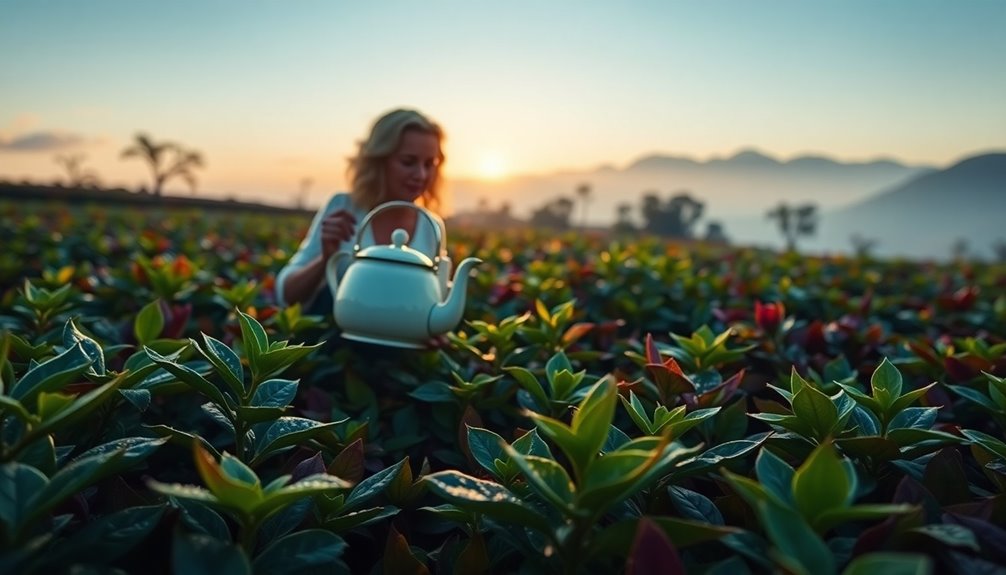
Henrietta Lovell, affectionately known as The Rare Tea Lady, brings a vibrant tapestry of tea culture to life through her remarkable journey.
As you delve into her book "Infused: Adventures In Tea," you'll discover her passion for high-quality loose tea that transcends the mundane experience of industrial teabags.
Lovell's travels take you through the lush tea gardens of China, where she immerses herself in the rich history of tea and the artisanal practices that define it.
Her writing intertwines personal anecdotes with educational insights, revealing the complexities behind various tea varieties and the optimal brewing techniques that lead to the perfect cup.
You'll learn about the intricate tea ceremony, a beautiful expression of tradition that elevates tea drinking into an art form.
Through her experiences, Henrietta Lovell inspires you to appreciate the nuances of tea, encouraging a shift in your own tea-drinking habits.
By highlighting the concept of tea-pairing in high-end restaurants, she draws exciting parallels between tea and culinary artistry.
With Lovell's guidance, you'll find yourself embracing a more mindful and quality-focused approach to tea.
Tea's Cultural Significance Explored

Tea serves as a universal bridge, connecting people across different cultures and backgrounds. You'll find that tea's cultural significance is profound, often symbolizing hospitality and connection.
In many Asian cultures, tea ceremonies are rituals that embody mindfulness and respect, showcasing the beauty in each step of preparation and consumption. For instance, the intricate Japanese tea ceremonies reflect Zen principles, creating a serene space for reflection and connection.
On the other hand, British afternoon tea emphasizes social gatherings, combining culinary delights with the art of conversation. Both traditions highlight how tea fosters bonds and creates cherished memories.
Historically, tea traveled along trade routes like the Silk Road, shaping economic and political landscapes, which speaks to its global importance.
You'll also notice tea's presence in literature and art, where it symbolizes comfort and the complexities of human relationships.
Through this exploration, you may find a lifelong love for tea, not just as a beverage but as a cultural phenomenon. By understanding these rich traditions, you deepen your appreciation for tea's role in connecting us all, transcending borders and time.
Global Tea Traditions Highlighted
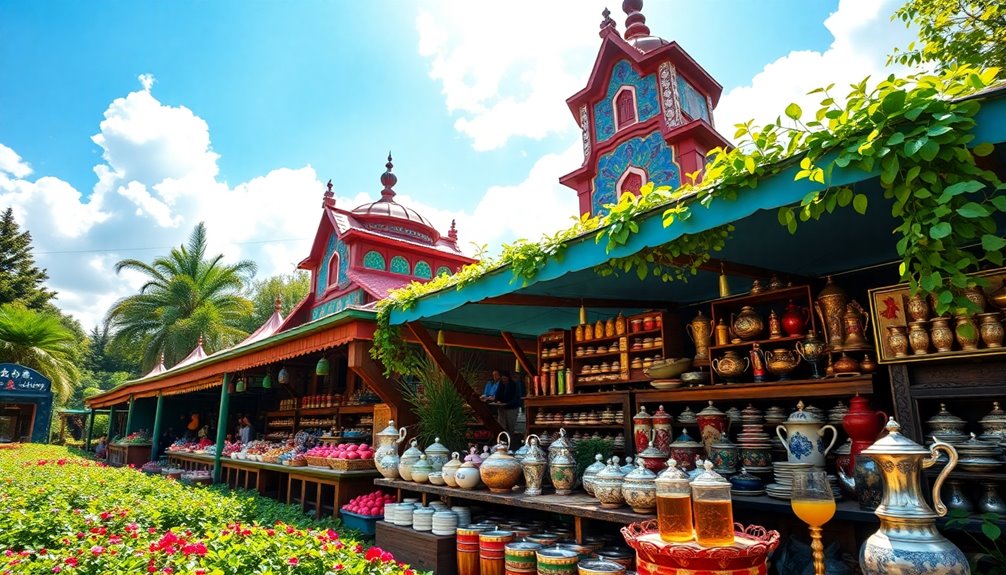
Exploring tea's cultural significance naturally leads to an appreciation of the diverse traditions that have emerged around it. Global tea traditions vary widely, from the British afternoon tea to the intricate Gongfu tea ceremony in China. Each ritual showcases the unique flavors and meanings associated with tea consumption in different cultures.
In India, for instance, chai is more than just a beverage; it's a symbol of hospitality and social connection, often enjoyed during gatherings.
As you delve into these traditions, you'll discover the importance of supporting small artisanal tea farms. These farms often embody environmental responsibility, ensuring sustainable practices while preserving local cultures. The book emphasizes that your tea choices impact not only your experience but also global communities involved in tea production. Additionally, the preparation methods, such as the use of specific utensils in traditional tea ceremonies, highlight the artistry and mindfulness integral to these rituals.
You'll also learn about the historical context of tea, including its rise as a status symbol in the UK during the 18th century, shaping social interactions and the British Empire's influence.
Cultural Appropriation in Tea Practices
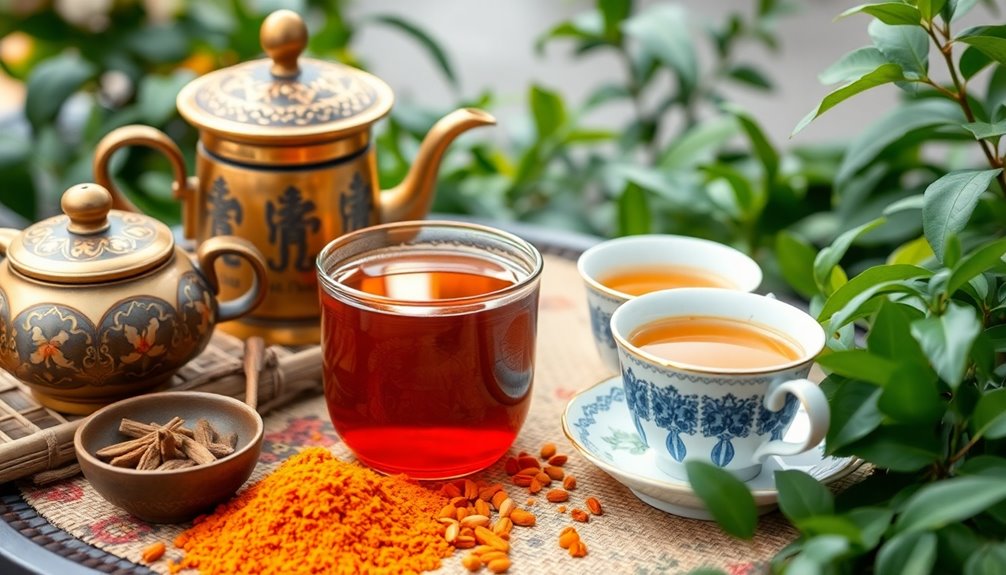
Cultural appropriation in tea practices raises important questions about respect and understanding when engaging with traditions from different cultures. It often occurs when traditional tea customs are adopted without a genuine appreciation for their origins.
For instance, the global fascination with matcha has transformed this ceremonial Japanese drink into a trendy ingredient, stripped of its historical significance. This commercialization can dilute the essence of tea traditions, favoring aesthetic appeal over authenticity.
Moreover, many tea brands tout a celebration of cultural heritage while relying on generic, mass-produced teas. This approach not only perpetuates stereotypes but also fails to support the artisan growers and communities that nurture these practices.
Engaging with tea respectfully means educating yourself about its origins and the rituals associated with it. When you appreciate the depth of traditional tea customs, you honor the cultures they come from. Additionally, understanding the caffeine content in various tea types can enhance your appreciation of their unique characteristics and cultural significance.
Practical Applications
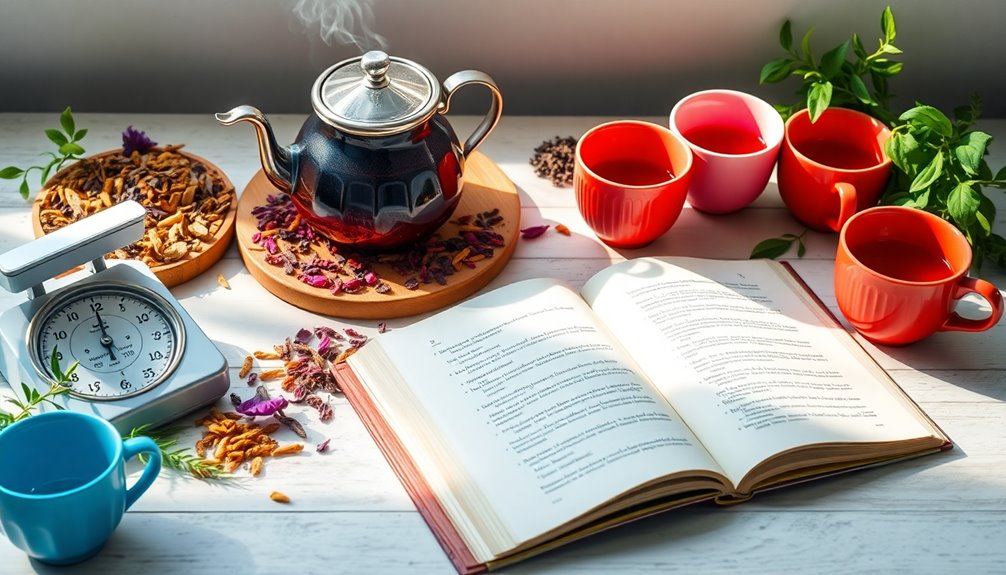
Understanding the significance of tea traditions sets the stage for practical applications that enhance your experience. I highly recommend switching to high-quality loose tea instead of industrial teabags. Loose tea not only delivers a richer flavor but also offers a more authentic experience.
Before drinking, take a moment to consider the optimal water temperature and steeping time for each type—this book provides detailed brewing instructions that can elevate your pot of tea.
Experimenting with different varieties is essential. For instance, green tea has its distinct characteristics that deserve exploration. The book encourages you to dive into the tea market, discovering unique flavors that resonate with your palate.
Moreover, don't overlook the food pairings included in the book. Matching tea with complementary dishes can elevate your dining experiences significantly.
Finally, embrace mindfulness practices around tea preparation and consumption. Taking time to appreciate each sip can transform your tea ritual into a sensory delight. Additionally, exploring the health benefits of herbal teas can further enhance your wellness journey.
Conclusion
In diving into Henrietta Lovell's journey, you've uncovered the rich tapestry of tea culture and its global traditions. You've learned to appreciate the nuances of each brew, recognizing the importance of ethical practices in tea consumption. This knowledge isn't just theoretical; it's something you can apply in your daily life, enhancing your tea experience. So, the next time you sip your favorite blend, remember the stories and traditions behind it, forever transforming how you enjoy tea.

